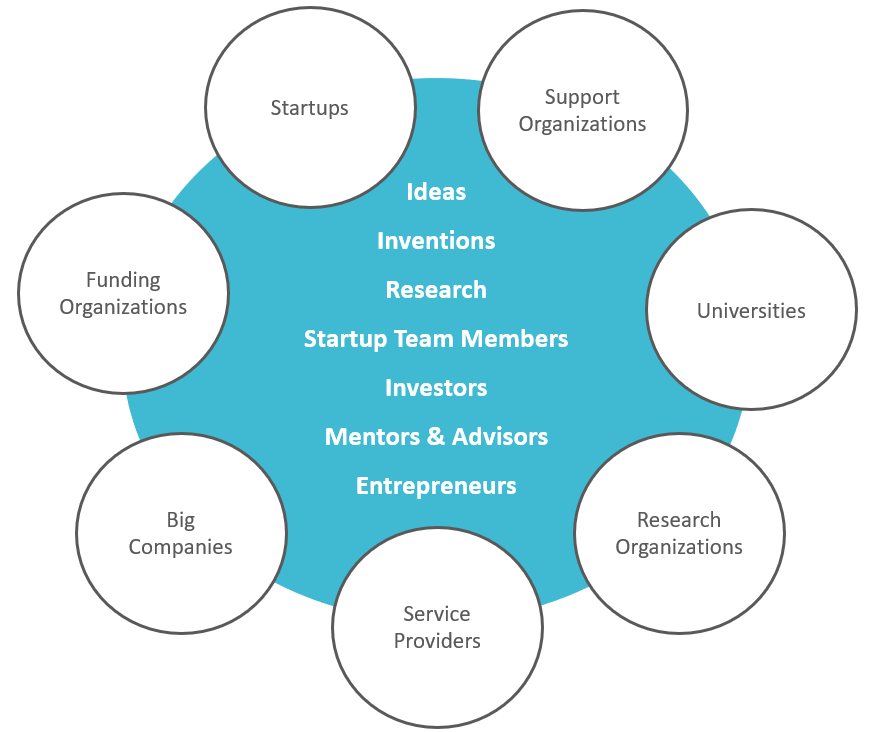
A startup ecosystem is a complex and dynamic network of people, organizations, ideas, and resources. These elements work together to create a physical or virtual environment suitable for launching and growing new startups.

External factors such as market trends, financial climate, local entrepreneurial culture, and politics can affect the structure and functioning of startup ecosystems. Internal factors include the sum of resources within the ecosystem, such as people, time, money, and skills.
The main idea is to grow and share the skills, ideas, and resources within the ecosystem so it remains conducive to progress and able to rebound from setbacks and disruptions.
In that sense, modern entrepreneurship and innovation ecosystems are tech-focused and intentional versions of old-school business districts. The goal is to attract all related stakeholders and activity at a single location in order to facilitate synergy and collaboration.
The most well-known example of a business ecosystem is the Silicon Valley ecosystem. It is a thriving tech hub that includes large firms, startups, top-class universities, law firms, accounting firms, and venture capital. All the elements of the system work together to promote startups, disruptive business models, and leadership in various areas of technology.
Less known initiatives on local levels can also take various forms of ecosystems.
For example, the Digital Hub in Ireland provides a collaborative space for hundreds of local digital companies to scale and grow. Based in Dublin, this digital community was launched by the Irish government in 2003 in order to promote innovation in the tech sector. Some of their alumni include Slack and Stripe.
While some ecosystems focus on attracting companies, others (such as Bali and Lisbon) are more focused on creating an attractive environment for digital nomads. Greece is rising in the rankings and working towards a "digital visa" to enable digital nomads to relocate to Greece with their families for three years. Athens is also working to address other issues such as insurance, healthcare, tax regime, and infrastructure networks to provide a seamless experience for high-income remote workers.
The benefits of startup ecosystems are multifold and include:
When these ecosystems are carefully planned and created, their impact potential is immense.

The advantages a startup ecosystem can bring to the local area include both tangible and intangible benefits:
Attracting talent and investment both locally and worldwide can provide the economic boost to improve both the living standard and interpersonal interactions.
Launching a startup comes with many challenges and any mistake can make or break a company.
An ecosystem can provide the company with the competitive advantage to succeed in uncertain times through:
Such ecosystems can set startups up for success, possibly reducing the current failure rates of around 90%.
The advantages provided to workers come from both the company and the ecosystem environment:
Being a part of a thriving community of innovators and driving change on both local and global levels can incentivize top talent to work on improving and growing the startup ecosystem further.

Ecosystems have the potential to be the driving force of economic development. But they need to be set based on some core principles to ensure lasting success. The companies within the ecosystem need to nurture the same values and philosophy.
Adapting the operating models to suit the workers can improve productivity and job satisfaction. In turn, people will buy into the vision and mission of the company and be more motivated to stay and advance its core values.
Customers and workers alike demonstrate rising focus on a business' purpose. Providing a good product while neglecting environmental and social impact will not be enough to keep a company sustainable.
Digitalization is in full swing and it will threaten anyone who doesn't adapt to the tech advancements available. Embracing new technologies and using analytics to track progress is the new norm.
There are two basic approaches to startup ecosystem creation.
The top-down approach is focused on building ventures, and it measures success through immediate outcomes such as the number of startups, capital raised, and startup valuation. This approach is used by most entrepreneurship programs today and it requires aspiring entrepreneurs to get it right the first time around. The support system consists of government agencies, industries, universities, and existing entrepreneurs.
The bottom-up approach, on the other hand, focuses on building the entrepreneurs of tomorrow. It merges a community of forward-thinkers and mentors with resources in collaborative workspaces. This approach provides a steady supply of entrepreneurs. The ecosystem itself is the support, providing the entrepreneurs that have failed once get back on their feet and try again.
Combining these two approaches would provide a steady supply of ideas and initiatives and the institutional and financial support required to keep the ecosystem running for the long term.
Different cities and countries need to carefully assess their local environment before launching the ecosystem initiative. This will ensure the ecosystem is focused on a suitable and profitable niche and the required infrastructure is in place (or can be built).
The local entrepreneurial culture, education levels, city and state policies, tax conditions, and many other factors can all affect the success of the startup ecosystem. Even access to legal and consulting services, office space, and internet speed can determine the ability to attract startups and digital workers.
Goals should be determined based on the needs and the potential of the local community. In the above example of Greece, they are working to attract digital nomads as the country offers high quality of living at a reasonable cost. On the other hand, Ireland's Digital Hub is more focused on building tech companies to further boost their recognition in the technology space.
As more digital hubs start to emerge, niching will become increasingly important, attracting the right companies and ensuring long-term economic impact.

Talent can be sourced locally through universities, colleges, and education providers. Or, it can be attracted from anywhere in the world when proper conditions are set up.
To create local talent, educational institutions can focus on improving and creating more programs for high-demand occupations. Entrepreneurship programs, courses can also be used to provide the necessary skills and grow the startup culture in students. Employment opportunities can then be created through apprenticeship training and hiring programs, ensuring a steady flow of qualified workers for the future.
An environment suitable for a startup ecosystem must provide founders the ability to access necessary funding. Venture capital firms, angel investors, or government loans can serve as incentives to entrepreneurs to bring their business into the local ecosystem.
Coworking spaces, equipment, housing, and means of transportation need to be available within the ecosystem. These, along with affordable resources, give startups the opportunity to minimize costs while securing proper working and living conditions for employees. Shared office spaces can also boost collaboration and creativity.
Availability of support programs such as incubators, accelerators, mentoring groups, as well as service providers helps create a stable and thriving ecosystem. The startup network built within and the community support also foster stability.
This can be a recipe for failure. To drive positive and sustainable change, communities should build systems that fit into their environment and create the most value within that specific environment.
Ecosystem builders may have many skills, but often need to consult experts that complement their knowledge and abilities. Without the view of the bigger picture, the entire structure can crumble.
It is good to have an overall strategy and goals, but being inflexible can be a costly mistake. Especially in the early days of an ecosystem, experimentation is in order. When fear of failure is eliminated, the structures that are set in place can provide the support to bounce back and discover what works best.
Ecosystem creation is a long-term effort and it may take decades to set up a stable and sustainable system. Creators should pay attention to existing and upcoming legal and regulatory policies, especially those that could affect the startup environment.
Many have tried to replicate the Silicon Valley ecosystem with varying degrees of success.

But to create a truly impactful startup ecosystem for the long term, several factors need to be taken into account:
There is no doubt that startup hubs can be significant drivers of innovation and prosperity. Creating the right conditions is essential to attracting, educating, and nurturing forward-looking individuals, companies, and organizations. These conditions need to be set at the local level by policymakers, organizations, communities, and individuals.
Local ecosystems can focus on attracting either companies or employees. To attract companies, the hubs should choose a narrow niche with good access to customers and cheap resources or labor. To attract employees, the ecosystems can leverage lifestyle, timezone, and age range as key factors.
Whatever the focus of the emerging ecosystem, proper infrastructure and legal framework need to be in place. Ensuring workers can get easy access to work visas and minimizing taxes should be at the top of the list.
Startup founders and investors have been operating in volatile environments for a long time. As a result, they have realized that startup ecosystems are much-needed structures that could provide the business models and support necessary to build thriving companies.
Policymakers are also starting to realize that drastic changes are needed to reinvigorate both local and global economies. Niched startup communities on the local level can connect key players and combine the most successful tactics to create value for cities and countries.
On the macro level, the goal of the startup ecosystems is to reconnect and realign businesses with economies and societies and ensure future stability and progress.
We Help Visionary Tech Entrepreneurs Build Impactful Companies!